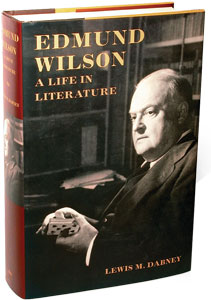Book Reviews
Edmund Wilson
 A Life in Literature
A Life in Literature
By Lewis M. Dabney,
New York: Farrar, Straus and Giroux, 2005
542 pages. $35.00
isbn 0374113122
Lewis Dabney has produced the definitive biography of Wilson, combining
the life, work, and literary history in roughly equal measures.
Edmund Wilson is often referred to as America's last
man of letters. He published fiction, poetry, plays, reviews, criticism,
and (posthumously) extensive journals and letters, yet he was never affiliated
with any academic institution. His reading was prodigious and his writing
equally so; in his lifetime he published some forty books over a fifty-year
career, with more than a dozen additional titles coming out after his
death.
Lewis Dabney, a professor of English at the University
of Wyoming, has produced the definitive biography of Wilson, combining
the life, work, and literary history in roughly equal measures. Dabney
met Wilson in the early 1960s and wrote his Ph.D. dissertation on him
in 1965. He edited Viking's Portable Edmund Wilson in 1983 (later expanded
as The Edmund Wilson Reader in 1997) and was selected to edit Wilson's
final volume of journals, The Sixties (1993). It can truly be said that
Dabney has been working on his subject for nearly forty-five years, and
a number of scholars, Wilson collectors, and educated readers have been
anticipating this book for the past decade.
Wilson was born May 8, 1895, in Red Bank, New
Jersey. He attended Princeton (class of '16) along with F. Scott Fitzgerald
(a lifelong friend), served in France from 1917 to 1919 as a stretcher-carrier,
and joined the staff of Vanity Fair in 1920. From 1925 to 1940, he was
the literary editor of The New Republic, then moved to The
New Yorker in 1943, an association that would last, with interruptions, to the end
of his life. Dabney covers Wilson's love affairs—noted in extravagant
detail in his journals—with Edna St. Vincent Millay, among others, and
his four marriages, including his stormy third marriage to Mary McCarthy
and his last one to Elena Mumm Thornton, partial heir to the champagne
fortune.
Dabney treats both the life and work, with extensive
analysis of Wilson's major books. He is especially good at covering events
leading up to Wilson's breakdown in 1929, and he gives shape to Wilson's
life and career by seeing the period after 1945 as "a second flowering,"
a period in which he settled down and began taking stock of his own life
and the literary life to which he had been witness for several decades.
Wilson's reputation rests on just a handful of
his books: Axel's Castle (1931), an explication of Yeats, Joyce, Pound,
Eliot, and other modernists; The Triple Thinkers (1938); The
Wound and the Bow (1941), which contains probably the best single essay on Dickens
by anyone; and the book most people know him by, To
the Finland Station: A Study in the Writing and Acting of History (1940), a study of Marxism
in which he gives full range to his understanding, experience, wide reading,
and abiding belief in the transformative power of history.
In the twenty years after World War Two Wilson
traveled extensively and continued writing, publishing nearly a dozen
titles, including his own favorite among his many books, Memoirs
of Hecate County (1946), a collection of six short stories that was banned as obscene
at one time. These two decades culminated in a major study, Patriotic
Gore: Studies in the Literature of the American Civil War (1962), a collection
of essays about the effect of the conflict on writers and other figures
both well known and obscure. Dabney devotes a chapter to the book.
Wilson's last decade was marred by declining
health and income tax troubles, but his mind continued to be curious
and probing as ever. The Bit Between My Teeth, third in a series collecting
his magazine pieces, appeared in 1965. It was followed six years later
by Upstate: Records and Recollections of Northern
New York, an exploration
of his family's past, their relation to the isolated environment of upstate
New York, and the central place in his life and theirs of the stone house
that had been in the family since the 1700s. Since his death there have
been nearly a dozen posthumous volumes, notably the five volumes of his
diaries, published by decade: The Twenties (1975) through The
Sixties (1993), all with skilled and informative introductory material and explanatory
notes, and three collections of letters.
Wilson received numerous awards late in life,
among them the Presidential Medal for Freedom in 1963; the MacDowell
Medal (1964); the National Medal for Literature (1966); and the Aspen
Award (1968). The news of his death on June 12, 1972, was given a full
page in The New York Times. His centennial in 1995 was observed with
programs at Princeton and at the Mercantile Library in New York, eventuating
a volume, Centennial Reflections, in 1997, also edited by Dabney.
Dabney's biography reminds us that not only are
Wilson's books well worth revisiting, but also that he truly was one
of the last of a vanishing breed. His messy life and astounding erudition
is captured in these pages in great detail, along with the literary culture
of sixty years from the heart of the American century.
Peter Coveney is a writer and editor who lives in
Connecticut.
 A Life in Literature
A Life in Literature